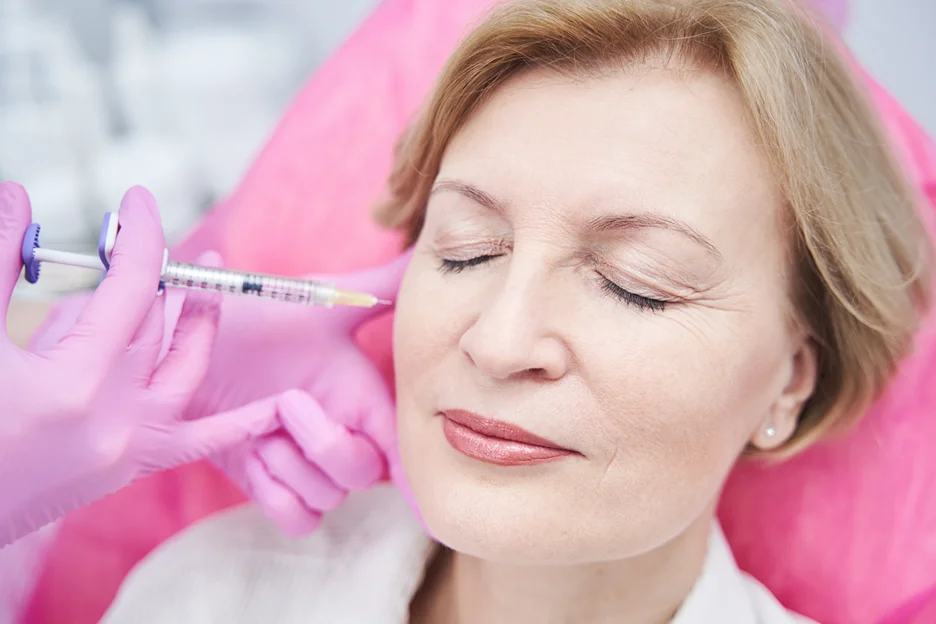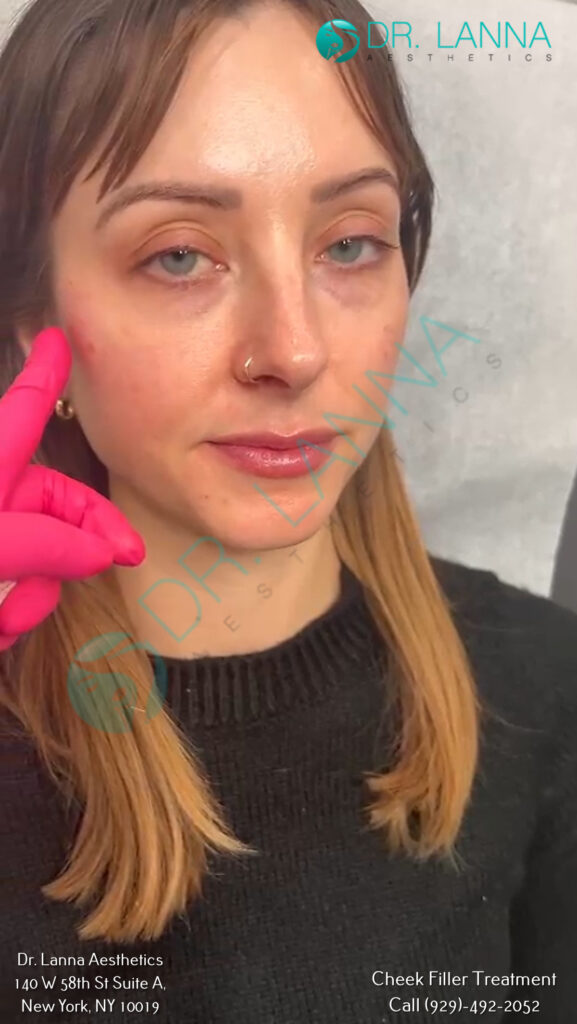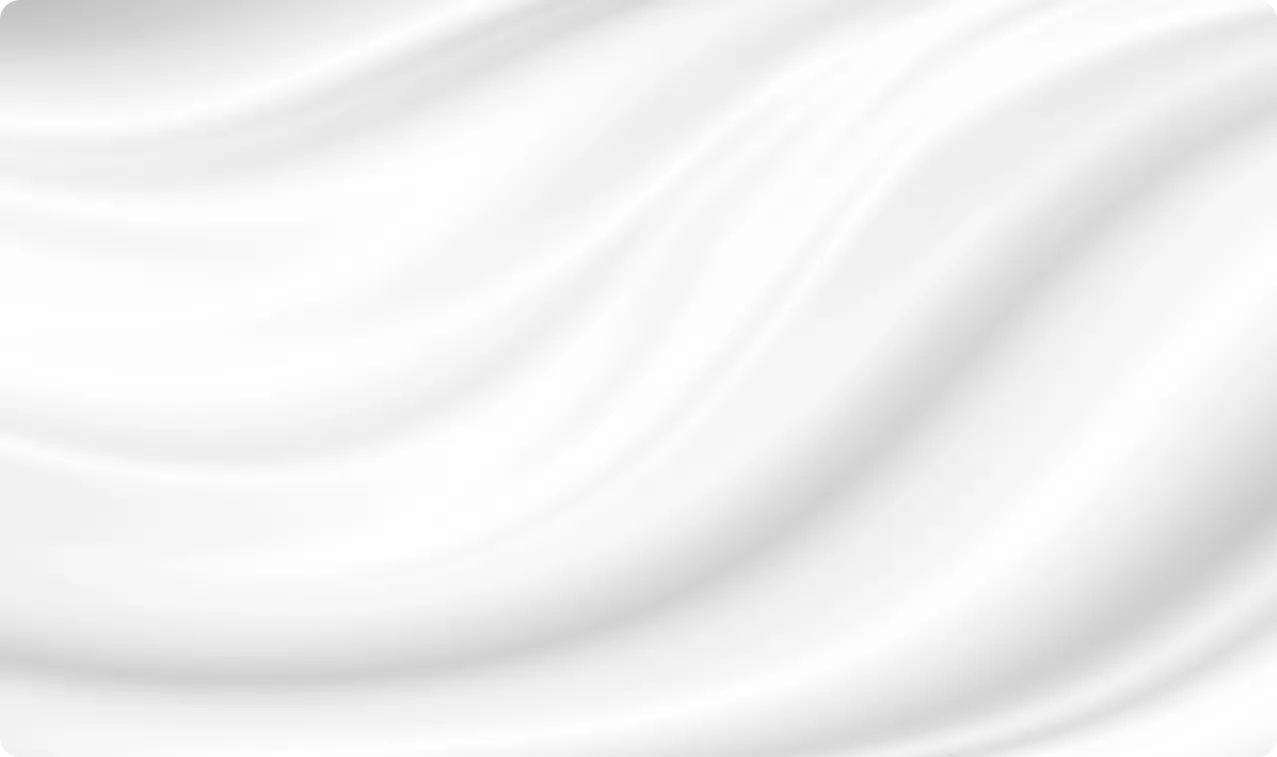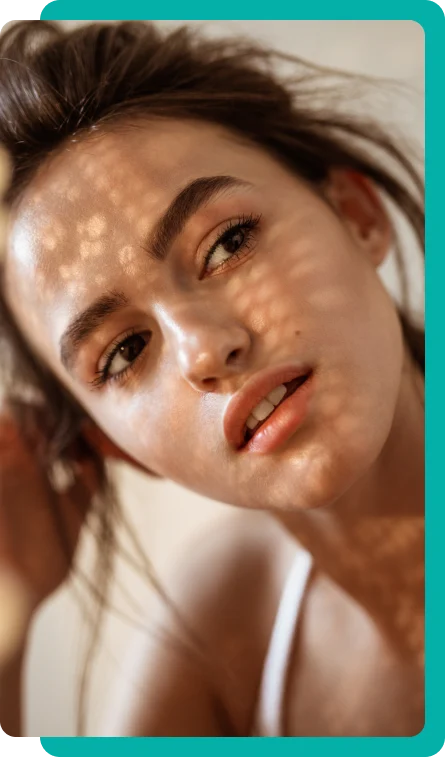Aging gracefully is a beautiful thing, but it’s completely normal to want to turn back time a little and restore the youthful fullness in your face. As we get older, our cheekbones tend to become less defined as facial fat pad shrinks and skin sags.
Hollow or sunken cheeks can make you look older and more tired. But it doesn’t have to be this way.
Dermal fillers offer a safe, effective way to plump up aging cheeks and bring back structure to your face. In skilled hands, a simple filler treatment can take years off your appearance without looking artificially puffy.
Here’s an in-depth guide on everything you need to know about getting cheek filler as a mature woman.
Aging causes two key changes that lead to sunken cheeks in women:
Your face is made up of discrete fat compartments. As we get older, the fat pads in our cheeks start to atrophy and deflate. This leads to a loss of support for the overlying skin, causing it to sag. The shrinking fat compartment leads to the appearance of hollows under the cheekbones.
Collagen and elastin fibers in the skin become weaker with age. This causes the skin on our cheeks to lose elasticity and droop downwards. Gravity also exacerbates this. This skin laxity accentuates cheek hollows and creates jowling.
Together, fat loss and skin sagging create the characteristic “skeletonized” look that can age the face. Cheek filler helps address both these issues for a rejuvenated look.

Dermal fillers are approved for use in people aged 22 and up. They are extremely effective at recreating a heart-shaped face regardless of your age. That said, there are some important factors to keep in mind:
| Factors | Description |
| Skin elasticity | Older skin has less ability to stretch. Overfilling cheeks can make skin appear taught and unnatural. A conservative approach is best. |
| Skin laxity | Aged women have more skin laxity. Fillers help fill hollows but don’t lift saggy skin. Combining fillers with threads or an Ultherapy skin tightening treatment is ideal. |
| Metabolism | Metabolism slows down with age, so results may last longer compared to younger women. Less frequent touch-ups are needed. |
| Bruising | Bruising can take longer to resolve in older patients, so avoid blood thinners like ibuprofen before treatment. |
In experienced hands, fillers can beautifully restore lost volume in aging cheeks and delay the need for a surgical facelift.
Cheek fillers replace lost volume in the midface for more matured women. Volumizing fillers like Juvederm can lift the jowls using a fine needle and restore cheek volume. The material then integrates into the skin's scaffolding.
The filler material attracts water molecules and expands, providing immediate volume to lift and plump up skin from inside. Results from these treatments are seen instantly. As your collagen grows into the filler material, results improve further over the next 2 weeks.
The filler supports the skin and creates a scaffolding structure that lifts sagging cheeks. This restores the plump, heart-shaped face of youth. Over time, your body naturally absorbs the filler.
The top picks for safe, effective cheek filler in mature women are:
| Filler | Description |
| Juvéderm Voluma | The gold standard cheek filler. Provides robust lift and projection for up to 2 years. |
| Restylane Lyft | Made specifically for midface injection. Lasts approximately 1 year. |
| Bellafill | 80% collagen-stimulating polymethylmethacrylate (PMMA) particles plus 20% hyaluronic acid. Provides 5+ year results. |
| Radiesse | Calcium hydroxyapatite-based filler that stimulates long-term collagen production. Lasts approximately 1-2 years. |
Your cheek filler consultation will be a comprehensive appointment with an experienced cosmetic provider to determine if you are a good candidate for this treatment. It will involve:
This customized consultation allows Dr. Lanna to develop an appropriate treatment plan addressing your unique concerns and facial profile.
Cheek fillers are very safe procedures with few side effects when properly performed by experienced injectors. However, there are some potential risks to be aware of.
Infection is very unlikely with today's sterilization practices but may require antibiotics if it were to occur. Under-eye swelling can happen with tear trough injections but generally resolves within a week.
Asymmetry is possible if different amounts of filler or techniques are used on each side, which could make the cheeks appear uneven. Using excessive amounts of filler can overfill the cheeks and stretch the skin, leading to an unnaturally wide or "pillow face" appearance.
Visible lumps or nodules can also form if filler is injected too superficially into the skin. Vascular occlusion, while very rare, involves blockage of an artery which could compromise blood flow and require hyaluronidase injection to dissolve the filler.
Bruising is also common but temporary; avoiding blood thinners before treatment can help reduce bruising risk. Supplements like arnica may also help.
Choosing an expert, experienced injector is key to minimizing risks and complications from cheek fillers. Get in touch with the team of Dr. Lanna Aesthetics today!
For significant sagging and loose skin on the cheeks, a surgical facelift may be required. But in earlier stages, fillers can rival a lift. Here’s how the two options compare:
| Procedure | Cheek Fillers | Facelift Surgery |
| Invasiveness | Minimally invasive, lunchtime procedure | Involves incisions and lifting of deeper facial layers |
| Anesthesia | Little to none | General anesthesia required |
| Recovery Time | Resume activities immediately | Significant swelling and bruising with 2 week recovery |
| Results | Adds volume to fill hollows. Provides moderate lift of mild to moderately sagging skin. Natural looking results that emerge gradually | Dramatic lifting of loose, sagging skin. It can comprehensively tighten cheeks, jowls and neck. Results look natural but surgical changes are noticeable |
| Longevity | Lasts 6-12 months typically and requires maintenance | Lasts 7-10 years typically |
| Main use | Early jowling and midface volume loss | Loose, sagging skin on cheeks, jowls and neck |
For mild to moderate cheek sagging, properly placed fillers can provide a mini “liquid facelift” while avoiding surgery. But for severe skin laxity, a surgical facelift is more effective at repositioning and tightening cheek skin.
Follow these tips to ensure proper healing and the best possible outcome after your cheek filler treatment:
Following proper aftercare protocols helps ensure the best results with minimal downtime or side effects.

Thanks to advanced dermal fillers, fuller, lifted cheeks are achievable at any age. If your mirror is starting to reflect a tired, hollowed appearance, cheek augmentation can refresh your look.
Dr. Lanna is an expert injector who has performed over 10,000 successful injections. Her artistry with fillers volumizes cheeks, smooths lines, lifts jowls, and enhances facial contours for a refreshed, youthful beauty. Contact the office today to learn more about achieving your aesthetic goals with expertly administered dermal fillers.
Cheek fillers can help restore volume loss in the cheeks that occurs with aging. This can result in a more youthful, lifted appearance. Fillers in the cheek area can also reduce the look of wrinkles, folds, and hollowness.
Hyaluronic acid fillers like Juvederm, Restylane, and Belotero are commonly used for cheek augmentation. These fillers provide a natural look and feel. Radiesse, a calcium hydroxylapatite filler, is also sometimes used.
With hyaluronic acid fillers, results typically last 6-12 months. Repeat injections are needed to maintain the effects. With Radiesse fillers, results may last 12-18 months or longer before a touch up is needed. The longevity depends on the individual and the amount injected.
Cheek fillers excel at restoring lost volume in sagging cheeks. As we age, skin becomes lax while fat pads deflate. This leads to loose, droopy skin on the cheeks with hollow areas underneath. Injecting dermal filler into sagging cheeks provides both structural support and volume.
Yes, cheek fillers and Botox work beautifully together! Cheek fillers like Voluma or Radiesse lift and volumize a flat midface. This restores the plump cheek contours of youth. Strategically placed Botox relaxes muscles around the eyes, forehead and jawline that contract with age.

New Patients Enjoy $100 OFF on Tox or Filler Appointments!
*minimum 1 full syringe or minimum 25 units; Cannot be combined
